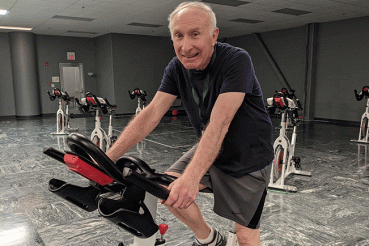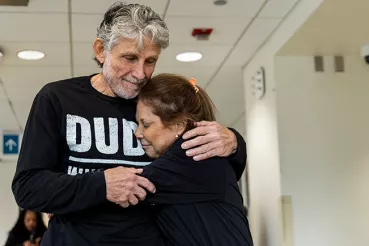Tracy Schumpp enjoyed living an active lifestyle, including hiking and other outdoor activities. But in January 2021, she experienced pain in her left hamstring, which she assumed was simply a pulled muscle. Her life changed when her primary care physician ordered an MRI, which revealed a tumor on her femur.
Within a week of the initial biopsy, Rush assembled a team of oncology and radiology specialists to develop a treatment plan. Tracy received 25 radiation treatments to shrink the tumor, followed by surgery to remove it, along with about a quarter of her hamstring. Finally, she went through several cycles of chemotherapy to get rid of the cancer.
“Rush was the first and only place I considered for my care,” Tracy says. “My husband was treated for throat cancer at Rush 12 years ago, and we were happy with the hospital and staff there.”
The successful treatment saved Tracy’s life, but the location of the tumor left her with permanent nerve deficit that compromised her ability to walk.
Specialized cancer rehab
There was no question that Tracy was going to need extensive physical therapy to help her return to her active life with as few lingering effects as possible. Having participated in physical therapy before, she was expecting the typical process: She would receive a prescription and then would be left to find a physical therapist on her own. Once there, she would work primarily with physical therapy aides while the primary therapist would periodically check in and modify exercises.
But Rush had recently partnered with a national cancer rehabilitation program, whose therapists are specially trained in recovery from cancer through physical and occupational therapy, speech-language pathology and cognitive rehabilitation.
For Tracy, the difference was immediate. Instead of being left with her prescription in hand and to find her own physical therapist, she received a call to help set up her appointment.
According to Patti Piasecki, a nurse practitioner at Rush who specializes in cancer care, this program is a game changer.
“I’ve been with ortho-oncology for more than 35 years, and this is such a logical concept for these patients with cancer,” Piasecki says. “We put in an order and they called her. She didn’t have to pound the pavement to find a place and make sure her insurance would cover her care. The cancer rehabilitation team does it all for them.”
Incredible progress
Although the surgery saved her life, it left her with a few issues with walking but that could be alleviated through therapy. In addition, cancer treatments take a huge toll on patients, and it’s essential that they keep up their strength and endurance.
“Any patients who are about to undergo cancer treatments or surgery can benefit greatly from physical therapy,” says Abby Lorder, a cancer rehab physical therapist. “We want to make sure they’re not a fall risk, especially because treatments cause a great deal of fatigue. It’s important that patients can continue to live their lives with as few safety issues as possible.”
Tracy was extremely motivated to get back on her feet. And according to her care team, she would always complete her home exercises and was able to maintain much of her strength and endurance throughout her cancer treatments.
While the nerve damage from the cancer left her with muscular weakness that makes it difficult to lift her toes, known as drop foot, Tracy has made incredible progress toward regaining her active lifestyle.
“Tracy has done amazingly well in spite of having a permanent neurological deficit,” Piasecki says. “I’ll attribute that to the medical staff at Rush, the cancer rehabilitation team, and Tracy’s determination and positive attitude.”




